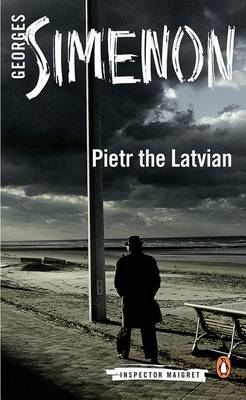
EURO CRIME
Reviews

Simenon, Georges - 'Pietr the Latvian' (translated by David Bellos)
Paperback: 162 pages (Nov. 2013) Publisher: Penguin Classics ISBN: 0141392738
His pipe was nailed to his jawbone. He wasn't going to remove it just because he was in the lobby of the Majestic.
Paris, c. 1930
Chief Inspector Maigret of the Flying Squad stokes the heat of his office stove and reads the translated telegram once more. "Krakow Police report sighting Pietr the Latvian en route to Bremen." Pietr the Latvian - a notorious figure in the world of organised crime; a shadowy con-man sought by every police force on the continent. Maigret sets off immediately for the Gare du Nord. There, amongst the hubbub of arrival, his eye is drawn to a man surrounded by a retinue of porters being guided along the platform by the representative of a grand Parisian hotel. As Maigret turns to follow this group onto the concourse, the barrier chain is drawn across the platform. There is uproar further down the train; a dead man in Carriage 5. Maigret pushes through to examine the corpse. Shot in the chest. And fitting the description of The Latvian. But Maigret has a feeling about the wealthy traveller heading for the Hotel Majestic. Maigret proceeds to the hotel and seats himself outside the open door of the new arrival's suite. He strikes up his pipe. The man looks at Maigret but coolly continues his instructions for the stowing of his belongings. It will be a three-pipe wait until the man emerges from his suite, dinner-jacketed and elegant. He stops in front of Maigret and looks at him, then moves off to the lift and descends to the hotel dining room. Maigret persists in his tracking of the wealthy "Mr Oppenheim" and observes him dining with a celebrated millionaire couple, the Mortimer-Levingstons. An hour or two later, both Oppenheim and Mortimer-Levingston have disappeared from the hotel.
Back at police headquarters, Maigret's assistant Torrence reveals the only object to be found on the dead man at Gare du Nord - a strand of hair in a glassine envelope of the kind used to protect photographs. The police laboratory extracts an imprint of the photographer's address from the envelope: Fécamp, a harbour town in Normandy. Maigret is in a dilemma. He establishes Detective Torrence at the Hotel Majestic to keep watch for Oppenheim and Mortimer and himself catches the train to Fécamp. In torrential rain he stands in an alleyway leading from the harbour and observes one of the respectable looking villas above. When a scruffily dressed man leaves the villa, Maigret follows him to a harbour-side bar. There the man, who also resembles The Latvian, drinks cheap absinthe steadily. Eventually Maigret shares their third class carriage back to Paris, observing all the while the man's drunken slumped figure...
Despite having read crime fiction for decades, I have never read the classic Maigret stories of Belgian writer Georges Simenon. Now Penguin is re-publishing the Maigret series at "one a month" starting in November 2013. So this is my chance. The first in the series, PIETR THE LATVIAN, was originally written in serial form and published as such in 1930. Simenon started his career as a journalist and there is certainly a wonderful eye for pungent detail in PIETR THE LATVIAN. In fact this is not quite the book which I expected. It is indeed a mystery story, not least as to the true identity of the Latvian. But translator David Bellos gives us bold, muscular language, as blocky and strong as the figure of Maigret himself. With it comes a fresh, surprisingly timeless view of a world of swanky hotels and nightclubs set side by side with seedy bars and the crowded rooming-houses of the immigrant quarter. Throw in the rainy harbour town of Fécamp in Normandy and you get a reading experience as varied in appearance and flavour as Pietr the Latvian himself. This is a compact novel whose brevity is packed with enough plot and psychological content to enable the reader to see the qualities that will influence so many crime writers to come. I have a copy of the second in the series, THE LATE MONSIEUR GALLET, on my bookshelf and am eager to read it - not least because Penguin appear to have designed the series so that each novel will be interpreted by a different translator. This is just another reason why this series should enable its readers to enjoy the essence of Simenon's writing and of Maigret himself. Don't miss out on this chance to read this revitalised classic crime series. A must.
Lynn Harvey, England
October 2014
More European crime fiction reviews can be found on the Reviews page.